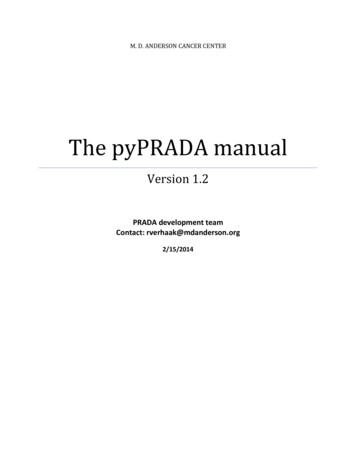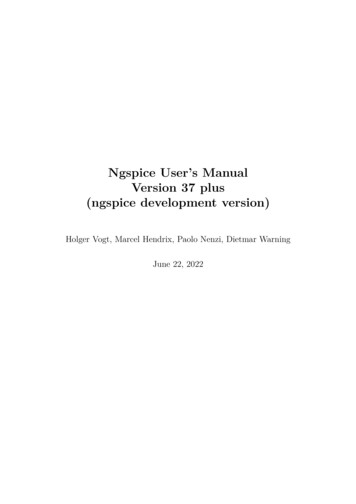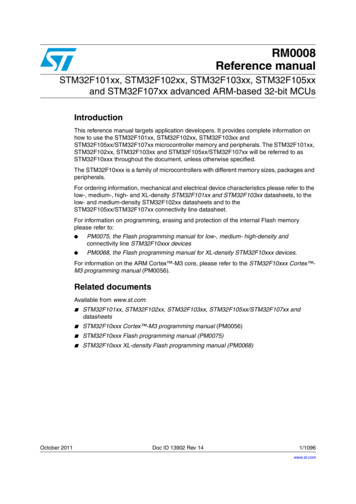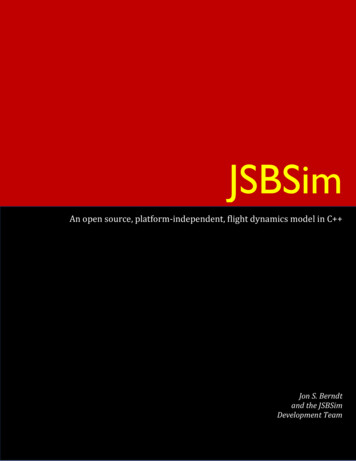
Transcription
M. D. ANDERSON CANCER CENTERThe pyPRADA manualVersion 1.2PRADA development teamContact: rverhaak@mdanderson.org2/15/2014
ContentsOVERVIEW. 21.1 Background . 21.2 Summary of available modules . 21.3 Terminology . 21.5 Implementation and Computing Requirements . 3INSTALL . 32.1 Setting up the configuration file (conf.txt) . 32.2 Installation of required Software and Packages . 62.2.1 Install Python . 62.2.2 Installation of Python packages Pysam and Biopython . 72.2.3 set pyPRADA to system path . 7USAGE . 73.1 preprocess. 83.2 fusion module . 103.3 guess-ft. 113.4 guess-if . 123.5 frame . 123.6 homology . 133.7 Quick examples . 13DESCRIPTION. 144.1 PROCESSING . 144.2 GENE FUSION . 184.3 GUESS-ft: . 214.4 GUESS-if . 224.5 Frame . 234.6 Homology . 24REFERENCE: . 241
OVERVIEW1.1 BackgroundMassively parallel mRNA sequencing (RNASeq) provides accurate estimate of the quantity andcomposition of transcriptome. To facilitate the analysis of paired-end RNAseq data, we developed thePipeline for RnAseq Data Analysis (PRADA). The main focus of PRADA is to identify gene fusions andestimate gene expression. The BAM files generated by the pipeline are readily compatible with differenttools for further downstream analysis.This manual sought to describe available functionality of each module in PRADA.1.2 Summary of available modulesPRADA currently supports 6 modules to process and identify abnormalities from RNAseq data:preprocess:Generates aligned and recalibrated BAM files.fusion:Identifies candidate gene fusions.guess-ft:Supervised search for fusion transcripts.guess-ig:Supervised search for intragenic rearrangements.homology:Calculates homology between given two genes.frame:Predicts functional consequence of fusion transcript1.3 TerminologyThroughout this manual we refer to various terminologies which are commonly used in Next GenerationSequencing (NGS) and gene fusion analysis. The basic input to PRADA is a BAM file which is the binaryform of Sequence alignment/map format file.Template/Insert A sequence part of RNA/DNA which is sequenced on a sequencing machine.Read A raw sequence with quality scores coming off a sequencing machinePaired End/ Mate Pair A read pair that is sequenced from each end of the fragmented cDNA.Discordant Read Pair A read pair where each end maps to distinct genes.Junction Spanning Read A chimeric read that span a putative junction.2
Figure 1: Description of the Terminology1.5 Implementation and Computing RequirementspyPRADA was implemented in Python and wraps up following existing tools within the package: SamtoolsGATKPicardBWABLAST For further information about the installation refer section 2.In current release, the “preprocess” module runs on a Portable Batch System (PBS). The current versionof PRADA has been extensively tested on MD Anderson Cancer Center High Performance Cluster. Due tothe involvement of several memory/time consuming steps, preprocess module requires 8G memory andat least 8 computing CPUs. Gene fusion/guess modules require less resource (4G memory).INSTALLPRADA is written in python programing language and intended to run in a command line environmenton UNIX or LINUX operating systems. To run pyPRADA, download the pre-compiled package and unzipto preferred installation location. Email to PRADA authors to request for the references files ordownload from https://bcbweb.mdanderson.edu/main/PRADA:Overview. If you are running PRADAwithin MD Anderson Cancer Center, the references files are available in HPCC and DQS extraspace.2.1 Setting up the configuration file (conf.txt)3
Once the pyPRADA package is downloaded and extracted, update the conf.txt file based on where thereference files are stored. Users may download reference files ADA/. The configure file also includes parametersfor BWA alignments, recognizing the possible customization required by users. However, we note thatthe current pyPRADA setting has been extensively tested. Unless end users have a clear understandingof the parameters, we do not recommend changes of these parameters. Users may also updateparameters for PBS scripts. To guarantee extensibility, pyPRADA directly incorporates all inputs from thisblock (“—PBS—”) into the resultant PBS files. The minimum requirement is node and ppn. The numberof ppn should be equal to BWA aln –t to ensure compatible and maximal performance. The parametershave to be set accordingly as each run of the processing module requires different memory and runtimebased on the size of the sample. According to our experiences the default setting of 12 CPUs and 5 daysis acceptable to the majority of cases.Update the reference to the files and check if all the files are available in the reference folder. Pleasemake sure not to modify the key for different reference files defined in conf.txt. Please do not modifythe title of each block such as “–PBS—“ and “—REF—”.compdb fasta FASTA file with both genome and transcriptome.compdb faiIndex to the FASTA file generated using samtools. compdb map Tab-delimited file with chromosome boundaries along with transcripts and theirexon boundaries information .*Figure 2: Sample MAP filegenome fasta FASTA file of the whole genome.genome gtf GTF with gene annotation information.dbsnp vcf DB-SNP know SNPs in VCF format.select tx List of all the genes and their longest transcript.*4
Figure 3: Sample Longest Transcript filefeature file Transcript information based on genomic location.tx seq file FASTA file of the whole transcriptome.ref anno Annotation of transcripts with custom unique id.*Figure 4: Sample annotation file.ref map Tab-delimited file with transcripts and their exon boundaries information .*ref fasta FASTA file of transcriptome with unique id from ref anno as FASTA headers.*Figure 5: Sample custom FASTA file with modified header.cds file Coding region start and end from ENSEMBL.txcat file Primary transcript for each gene from ENSEMBL.* Indicates that the files are custom generated and cannot be downloaded from any of the databases.5
Once the configuration file is updated it should look like the figure below:Figure 6: Sample configuration fileThe PRADA development team is aware of redundant reference files, as many pieces of informationcould be extracted from the GTF file and composite FASTA file. We are working on restructuring the iomodule so that it requires a minimum set of files. We expect to have a much shorter list in the nextversion.2.2 Installation of required Software and PackagesIt is assumed that C, Perl v5.8.8 and Java v1.7.0 are installed, along with a PBS job scheduler withsufficient amount of memory and nodes are available. We note that the PBS script generated bypyPRADA is also a shell script that can be deployed in both T shell and B shell regardless of the presenceof a PBS scheduler. pyPRADA requires installation of Python and several third party packages to run thepipeline.2.2.1 Install PythonEnter the following commands to download and extract Python 2.7 to your hosting account.wget 2.tgztar zxfv Python-2.7.2.tgzcd Python-2.7.2./configure --prefix HOME/pythonmake6
make installTo make python2.7 as your default python, modify the .bashrc file (in B shell) in home directory.export PATH HOME/python/Python-2.7.2/bin/: PATHSave .bashrc and source the file or re-login to make the changes effective.source /.bashrcIn C-shell system, modify .cshrc file as followingsetenv PATH HOME/python/Python-2.7.2/bin: PATHSave and source .cshrc file.2.2.2 Installation of Python packages Pysam and BiopythonEnter the following commands to download and extract Pysam-0.6 [5].wget ztar zxfv pysam-0.6.tar.gzcd pysam-0.6python setup.py installwget http://biopython.org/DIST/biopython-1.60.tar.gztar zxfv biopython-1.60.tar.gzcd biopython-1.60python setup.py install2.2.3 set pyPRADA to system pathYou may set pyPRADA to system path. To do so, modify .bashrc file in B-shell or .cshrc in C-shell. See2.2.1.USAGEBelow are examples of typical PRADA usage. Using the “-h” option with PRADA modules will report a listof all command line options.7
3.1 preprocessAs TCGA RNA-seq data is provided as BAM files, PRADA is by default set up to start from BAMs.However, PRADA also works with FASTQ files – please see below.START FROM BAM: PRADA provides two versions of the preprocess module, determined by two centersin TCGA that produce slightly different RNA-seq BAM files: UNC (prada-preprocess-unc) and the BroadInstitute (prada-pre-process-bi). Both the modules are identical except for the first step where weconvert BAM to FASTQ. In the bi version we use Picard SamToFastq function and in the unc version weuse the ubu sam2fastq function. UNC generated BAMs have compatibility issues with standard BAMdue to the MapSlice alignment strategy. For this reason Picard SamtoFastq does not work for them.More details about the incompatibility can be found athttps://webshare.bioinf.unc.edu/public/mRNAseq TCGA/UNC mRNAseq summary.pdf. Werecommend testing both versions, to determine which works best for your BAM.START FROM FASTQ: To start PRADA from FASTQ files, paired end FASTQ files should be named toXX.end1.fastq and XX.end2.fastq. PRADA requires strict naming convention otherwise the package willreport error. Usage is similar to running the prepocess module with BAM files, only starting from step2 e1 1.Examples for both options are included in the package under folder name testdata.8
Running the preprocess module: The usage is identical in both unc/bi versions:prada-preprocess-unc -hPipeline for RNAseq Data Analaysis - preprocessing pipeline (PRADA).**Command**prada-preprocess -bam XX. -conf xx.txt -inputdir . -tag TCGA-XX -platform illumina step 1 1 -intermediate no --pbs xxx -outdir . -submit no**Parameters**:-hprint help message-step infoprint complete steps and output files of each step.-baminput BAM file, must has a .bam suffix.-refconfig file for references and parameters. Default is conf.txt in py-PRADA installationfolder. For reference files, each line is separated. The first field is keyword and shouldnot be changed. The second field refers to annotation files. PBS parameters are foronly required in process module.-taga tag to describe the sample, likely sample ID, such as TCGA-LGG-01; no default. Tag isused to define READ GROUP in the pipeline.-platformonly illumina at present (default).-stepvalues: 1 1/2,2 e1/2 1/2/3/4,3 e1/2 1/2,4 1/2,5,6 1/2,7,8; example 2 e1 1; nodefault. See –step info for details.-outdiroutput dir. Default is the directory where the input bam is.-pbsname for output pbs file and log file. Default (time-stamp) is used if no input.-intermediate values:yes/no; if intermediate files should be kept. Default is not.-submitIf submit the job to HPC, default is no.-vprint version information.9
Example:We assume the current working folder is the PRADA directory. A pbs file will be generated andautomatically submitted for each operation. If no submission is desired, change “-submit yes” to “no”. Amessage will be printed to stdout detailing the locations of the input BAM file, PBS file and resulting LOGfile.1. Run PRADA from BAM./prada-preprocess-bi -inputdir testdata -sample U87 chr17p13.2 -tag U87 -step 1 1 -pbs frombam -outdirtestdata/test1 -submit yes2. Run PRADA from FASTQ./prada-preprocess-bi -inputdir testdata -sample U87 chr17p13.2 -tag U87 -step 2 e1 1 -pbs fromfq -outdirtestdata/test2 -submit yesIMPORTANT: the job file can be run as a standalone shell script (using sh name of script or ./ name of script .3.2 fusion moduleRunning pyPRADA gene-fusion module:The command line parameters required to run prada-fusion are described in the -help option. prada-fusion -hPipeline for RNAseq Data Analaysis - fusion detection (PRADA).**Command**:prada-fusion -bam XX.bam -conf xx.txt -tag XX -mm 1 -junL XX -minmapq 30 -outdir ./**Parameters**:-hprint help message-bam input BAM file, must has a .bam suffix. BAM is the output from PRADA preprocessmodule. CAUTION: a non-PRADA BAM may give erroneous results.-confconfig file for references and parameters. Use conf.txt in py-PRADA installation folder ifnone specified.-taga tag to describe the sample, used to name output files. Default is ''.-mmnumber of mismatches allowed in discordant pairs and fusion spanning reads. Default is 1.-junLlength of sequences taken from EACH side of exons when making hypothetical junctions.No default. See details below.-minmapq minimum read mapping quality to be considered as fusion evidences. Default is 30.-outdir output directory.-vprint version10
NOTE: -junL parameter defines how the junctions are generated. For a pair of exons, the hypotheticaljunction is generated by adopting the 3’end junL bases from exon 1 and 5’ end junL bases from exon 2.There is no default value for -junL, it should be set based on the read length and quality of the bases ateach end of the read. The number must be less than the standard read length. For example if the readlengths of each end in a high throughput experiment is 50bp. Then the -junL can be set anywhere from35 to 49. Based on this number the exon-junction database is created, which is used to find junctionspanning reads which imply the existence of gene fusions. If you assign the junL value as 45, then PRADAgenerates a database of all possible exon junctions for genes within gene-pair and the length of eachsequence constituting the exon junction will be 90 bases. The sequence includes last 45 bases of an exonfrom 5' gene (geneA) and first 45 bases from the beginning of an exon in the 3' gene (geneB). Werecommend setting junL as the 80% of read length. For instance, if read length is 75, use junL 60.Unmapped reads with mate pair mapping to the genes in the recurrent gene-pairs list are aligned to thejunction database to identify the junction spanning reads. If the -junL is set more than the read lengththen the reads would not map the junction.Example:[MDAXX] prada-fusion -bam ed.flagged.bam –conf conf.txt-tag TCGA-A3-xxxx -mm 1 -junL 40 -minmapq 37 -oudir ./fusion3.3 guess-ftGuess fusion transcript is to search for evidences of fusions between GeneA and GeneB. The samebiological logic is applied as prada-fusion, but instead in a supervised fashion.python prada-guess-ft -hUsage: prada-guess-ft GeneA GeneB -conf xx.txt -inputbam X -mm 1 -minmapq 30 -junL X -outdir X unmap X**Parameters**:-confthe configure file. see prada-fusion -ref for details-inputbamthe input bam file-mmnumber of mismatch allowed. Default is 1.-minmapqmininum mapping quality for reads to be used in fusion finding-junLlength of exons to be used for junctions. see prada-fusion-outdiroutput directory-unmapthe numapped reads. useful if user need to run guess-ft multiple timesExample:11
Run guess to search for FGFR3-TACC3 fusion:[MDAXX] prada-guess-ft FGFR3 TACC3 -conf conf.txt -inputbam d.flagged.bam -mm 1 -junL 40 -minmapq 30 -outdir ./guessRun guess to search for EGFR-TACC3 fusion by setting unmapped.bam from earlier run:[MDAXX] prada-guess-ft EGFR TACC3 -inputbam d.flagged.bam -mm 1 -junL 40 -minmapq 30 -outdir ./guess –unmap unmapped.bam3.4 guess-ifThe guess intragenic fusion usage is quite similar as guess-ft. Only the gene in which the intragenicdeletion has to be deleted must be mentioned here. prada-guess-ifUsage: prada-guess-if Gene -conf xx.txt -inputbam X -mm 1 -minmapq 30 -junL X -outdir ./ -unmap X**Parameters**:-confthe configure file. see prada-fusion -ref for details-inputbamthe input bam file-mmnumber of mismatch allowed-minmapqmininum mapping quality for reads to be used in fusion finding-junLlength of exons to be used for junctions. see prada-fusion-outdiroutput directory-unmapthe numapped reads. useful if user need to run guess-ft multiple timesExample:Run guess to search for EGFR-TACC3 fusion:[MDAXX] prada-guess-if EGFR -conf conf.txt -inputbam d.flagged.bam -mm 1 -junL 40 -minmapq 30 -outdir ./guessRun guess to search for EGFR-TACC3 fusion by setting unmapped.bam from earlier run:[MDAXX] prada-guess-if EGFR -inputbam ed.flagged.bam mm 1 -junL 40 -minmapq 30 -outdir ./guess –unmap unmapped.bam3.5 frameUsed to classify list of gene fusions and their junction sites to in-frame or out-frame. The input file is atab delaminated file with gene names and the junction boundary location.12
prada-frame -hUsage: prada-frame -conf xx.txt -i inputfile -docstr XX -outdir ./**parameters**-conf-isee prada-fusion -confinput file, a tab/space delimited four-column file, each row like "GeneA GeneA break GeneBGeneB break" Example:FGFR3 1808661 TACC3 1739325-docstr outfile prefix. output to two files: XX.frame.brief.txt, XX.frame.detail.txt-outdir output directory, default is ./Example:Run frame to classify fusion:[MDAXX] prada-frame -conf conf.txt -i input.txt –docstr output -outdir ./guess3.6 homologyUsed to obtain homology score between the two genes in the fusion. prada-homologyUsage: prada-homology -conf xx.txt -i inputfile -o outputfile -tmpdir XXX**parameters**-confsee prada-fusion -conf for details-ia tab/space delimited two-column file --- gene1 gene2-ooutput file-tmpdirtemporary directory that saves fasta filesExample: prada-homology -conf conf.txt -i homology test.txt -o homology scores -tmpdir ./GUESS ft3.7 Quick examplesIn this release, we provide a test data set in the package under the folder “testdata”. This small data setwas excerpted from U87 RNAseq (SRA accession number: SRX070907) but only contains 262,009 read13
pairs mapping to cytoband chr17p13.2. A gene fusion SPAG7-CAMTA2 was found in this region byPRADA, defuse and TopHat-Fusion.In the folder we also included frame test.txt for testing frame prediction module, homology text.txt fortesting homology prediction module. Example command lines were included in the readme.txt file. Thepreprocessing takes 20-30 minutes to finish.DESCRIPTION4.1 PROCESSINGThe purpose of the processing module is to realign short reads to both transcriptome and genome.Although time consuming, this step is essential because a given input BAM file may be generated by verydifferent sequence alignment tools and thus vary substantially in read alignment structure. This modulefirst converts the BAM file into a FASTQ file and aligns them to ref genome and transcriptome usingBWA, and remaps the resulting BAM file to convert the transcriptome locations to genome locations.Then, it merges the two ends into a paired BAM file and recalibrates the quality scores for the BAM file.Finally it marks the duplicate reads and generates index file for further downstream analysis. The twostep alignment strategy is essential in RNAseq processing. For details, see M. Berger et al, Genome Res,2010.These steps are performed using multiple tools like BWA, GATK, Picard and samtools. The pyPRADAmodule generates a PBS file which calls the steps one after the other in a sequential format. The toolsare wrapped along with the pyPRADA package. For system without PBS or similar scheduler installed,users the PBS file can be used simply as a shell script.pyPRADA can be re-started at any step by passing parameter step (e.g. -step1 1/2,2 1/2/3 e1/e2,3 1/2 e1/e2,4 1/2,5,6 1/2/3,7 1/2,8 1). To start pyPRADA from anintermediate step, it requires the output files generated in the previous step. If the files are deleted thenstart it from the first step.Note: After each step the files generated in the previous step are deleted. Please set the parameter intermediate as YES if you want to keep the intermediate files. This will help the user debug errors in thepipeline.STEP 1Based on how the input BAM file was generated, pyPRADA provides two versions of the processing stepwhich differ in the conversion of BAM to FASTQ step, one uses Picard SAMtoFASTQ and other uses ubu1.2-jar-with-dependencies.jar which was referred by UNC for samples processed by them (MAPSPLICEaligner). UBU requires the initial BAM file to be sorted by read name so in the initial step 1 1 it sorts theBAM file using samtools and in step 1 2 it converts the BAM to FASTQ file. Whereas, if you use thePicard version of the pyPRADA you will have just one step 1 1 which converts BAM to FASTQ file.STEP 214
BWA (Burrows-Wheeler Alignment) is used in the second step of pyPRADA to align the reads to thereference genome and transcriptome. The publicly available version of BWA usually reports onealignment per read. Nonetheless to benefit from the PRADA alignment strategy of mapping to bothgenomic and transcriptomic references, BWA was customized to print all the alignments a read contains.This will allow conserving the alignment information from both genome and transcriptome. CustomBWA is used to align the FASTQ files to both genome and transcriptome at once. All the requiredreference files are defined in the config file. The reference file contains both the genome andtranscriptome sequence information in a concatenated form to perform alignment at once. If errorsoccur in this step please re-run the same step to ensure it is not an error from the Linux server but fromthe tool. If the error is from the BWA tool then search for the encountered error in the BWA mailing listand debug the error accordingly. If an error occurs while processing the step 2, pyPRADA can be resubmitted from the current step by setting the parameter -step "2 e1 1” or -step "2 e2 1". However,this requires the existence of both end [1-2] FASTQ files generated in the first step. If those files aredeleted then the pipeline needs to be run from the beginning.The step 2 2 aims to generate SAM (Sequence Alignment/Map) files from its .sai index and referencesequence files using a customized version of BWA. SAM is the generic format for storing large nucleotidesequence alignments data. The parameter '-s' in the customized BWA allows the reporting of multiplealignments per read which enables the integration of genome and transcriptome mapping. Same as step2 1, the generation of SAM file includes two steps 2 e1 2 and 2 e2 2, these steps are calledsequentially to process end1 and end2 SAI files respectively. If errors occur resubmit the step to ensureerrors are not related to Linux server or job scheduler. If errors persist in this step proceed to search inthe BWA mailing list for a fix. Some errors might be related to the customization done to BWA. Pleaseemail to PRADA authors in regards with specific errors related to the customization done to BWA fordebugging help.In step 2 3 aims to generate sorted BAM file from the SAM file. BAM is the binary version of the SAMfile and generated using the samtools view command. Samtools view function is used to convert theSAM to BAM in step 2 e1 3 and 2 e2 3.In step 2 4 the resulting BAM file is sorted by read name using samtools sort function. Samtoolsperform merge sort which generates number of temporary files which are automatically deleted at theend of sorting step. The sorting step is time consuming and performing the step twice for each end isone of the bottle necks of processing steps. If there are errors resubmit the step to ensure no errorswere caused from Linux server or job scheduler by passing parameter -step 2 e1 4 or 2 e2 4 based onwhich step the error occurred. If the input SAM files are missing then you will have to re-start from step2 3 or step 1. If the errors persist, search for a fix in samtools mailing list.Once the SAM file is generated, all the intermediate ".sai", ".fastq" and ".sam" files will be deleted. Theparameter -intermediate should be set to YES to keeping the intermediate files.STEP 315
Earlier, the reads are aligned to both the genome and transcriptome. In this step theremapTranscriptome tool from GATK is used to map transcript placements to genomic coordinates,preserving intronic information and filtering reads with ambiguous placements. This tool requires thetranscriptome to genome mapping information and the genome reference file to perform remapping.The resulting remapped BAM file is named as ".remapped.bam". For more information on how this toolworks please refer to Michael F. Berger et.al. 2010 [2]. This jar executable is customized and is notcurrently available in the public release of GATK 1.5-32 or earlier versions. No help information is foundin the mailing list or FAQ of GATK since this is an unpublished custom utility. Re-running the step byusing -step 3 e1 1 or 3 e2 1 is encouraged if errors are encountered. If the sorted bam files are missingthan re-start the pipeline from step 1 or 2 based on the availability of input files. Otherwise trycontacting the authors of PRADA if errors persist.The step 3 2 is identical to the 2 4 step; the remapped BAM file is sorted by read name using samtoolssort function. Similarly, this step also has 3 e1 2 and 3 e2 2 to sort end1 and end2 remapped bam filesrespectively and the sorted files have an extension "sorted.remapped.bam". If there are errors in thisstep, re-run the current step by passing the parameter -step 3 e1 2 or 3 e2 2 based on the step inwhich the error occurred. If the input files are missing then restart from step 3 1 or earlier steps basedon the availability of required files. Once the sorted remapped bam files are generated, the intermediatesorted.bam and remapped.bam files are deleted.STEP 4Up to this step, the RNAseq data is analyzed separately for end1 and end2. In this step the processedBAM (“sorted.remapped.bam”) files from both ends are combined into one bam file with nameextension "paired.bam". The FLAGS for each mapped reads are updated by 0x40 and 0x80 whichindicates the first and last segment in the template. The tool pairMaker is a customized jar executablewhich is not currently available in the public release of GATK 1.5.32 or earlier versions. If errors areencountered at this step resubmit by assigning the parameter -step 4 1. If the “sorted.remapped.bam”files are missing than re-start the pipeline from step 3 or 1 based on the availability of input files. Sincethis is a customized tool, no documentation can be found through the GATK website. If you need furtherinformation to debug errors or understand the process please contact the authors of PRADA.The step 4 2 is simila
4 Once the pyPRADA package is downloaded and extracted, update the conf.txt file based on where the reference files are stored. Users may download reference files at










